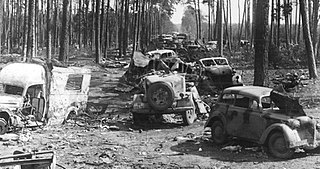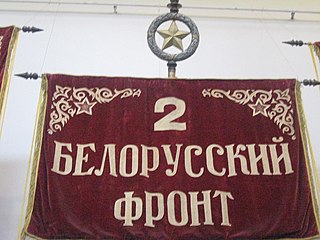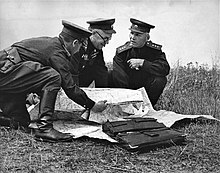
Georgy Konstantinovich Zhukov was a Marshal of the Soviet Union. He also served as Chief of the General Staff, Minister of Defence, and was a member of the Presidium of the Communist Party. During World War II, Zhukov oversaw some of the Red Army's most decisive victories, after which he was appointed the military governor of the Soviet Occupation Zone in Germany.

The Battle of Berlin, designated as the Berlin Strategic Offensive Operation by the Soviet Union, and also known as the Fall of Berlin, was one of the last major offensives of the European theatre of World War II.

Ivan Stepanovich Konev was a Soviet general and Marshal of the Soviet Union who led Red Army forces on the Eastern Front during World War II, responsible for taking much of Axis-occupied Eastern Europe.

Konstantin Konstantinovich Rokossovsky was a Soviet and Polish officer who became a Marshal of the Soviet Union, a Marshal of Poland, and served as Poland's Defence Minister from 1949 until his removal in 1956 during the Polish October. He became one of the most prominent Red Army commanders of World War II.

Felix Martin Julius Steiner was a German SS commander during the Nazi era. During World War II, he served in the Waffen-SS, the combat branch of the SS, and commanded several SS divisions and corps. He was awarded the Knight's Cross of the Iron Cross with Oak Leaves and Swords. Together with Paul Hausser, he contributed significantly to the development and transformation of the Waffen-SS into a combat force made up of volunteers and conscripts from both occupied and un-occupied lands.

The Battle of Halbe was a battle lasting from April 24 – May 1, 1945 in which the German Ninth Army—under the command of General Theodor Busse—was destroyed as a fighting force by the Red Army during the Battle of Berlin.

Helmuth Otto Ludwig Weidling was a German general during the Second World War. He was the last commander of the Berlin Defence Area during the Battle of Berlin, led the defence of the city against Soviet forces and finally surrendered just before the end of World War II in Europe.

2nd Belorussian Front a major formation of the Soviet Army during World War II, being equivalent to a Western army group.

The 1st Belorussian Front, known without a numeral as the Belorussian Front between October 1943 and February 1944, was a major formation of the Red Army during World War II, being equivalent to a Western army group. The 1st Belorussian Front along with the 1st Ukrainian Front were the largest and most powerful among all Soviet fronts, as their main effort was to advance on the Nazi German capital Berlin.

The 9th Army was a World War II field army. It was activated on 15 May 1940 with General Johannes Blaskowitz in command.

The Vistula–Oder offensive was a Red Army operation on the Eastern Front in the European theatre of World War II in January 1945. The army made a major advance into German-held territory, capturing Kraków, Warsaw and Poznań. The Red Army had built up their strength around a number of key bridgeheads, with two fronts commanded by Marshal Georgy Zhukov and Marshal Ivan Konev. Against them, the German Army Group A, led by Colonel-General Josef Harpe, was outnumbered five to one. Within days, German commandants evacuated the concentration camps, sending the prisoners on their death marches to the west, where ethnic Germans also started fleeing. In a little over two weeks, the Red Army had advanced 480 kilometres (300 mi) from the Vistula to the Oder, only 69 kilometres (43 mi) from Berlin, which was undefended. However, Zhukov called a halt, owing to continued German resistance on his northern flank (Pomerania), and the advance on Berlin had to be delayed until April.

The Battle of the Seelow Heights was part of the Berlin Strategic Offensive Operation. A pitched battle, it was one of the last assaults on large entrenched defensive positions of the Second World War. It was fought over three days, from 16–19 April 1945. Close to 1,000,000 Soviet soldiers of the 1st Belorussian Front, commanded by Marshal Georgy Zhukov, attacked the position known as the "Gates of Berlin". They were opposed by about 110,000 soldiers of the German 9th Army, commanded by General Theodor Busse, as part of the Army Group Vistula.

The Battle of the Oder–Neisse is the German name for the initial (operational) phase of one of the last two strategic offensives conducted by the Red Army in the Campaign in Central Europe during World War II. Its initial breakthrough phase was fought over four days, from 16 April until 19 April 1945, within the larger context of the Battle of Berlin. The Soviet military planners divide the frontal and pincer phases of the operation, named Berlin Strategic Offensive Operation into:

The 1st Ukrainian Front, previously the Voronezh Front, was a major formation of the Red Army during World War II, being equivalent to a Western army group.

The 1945 Moscow Victory Parade, also known as the Parade of Victors, was a victory parade held by the Soviet Armed Forces after the defeat of Nazi Germany. This, the longest and largest military parade ever held on Red Square in the Soviet capital Moscow, involved 40,000 Red Army soldiers and 1,850 military vehicles and other military hardware. The parade lasted just over two hours on a rainy June 24, 1945, over a month after May 9, the day of Germany's surrender to Soviet commanders.

The battle in Berlin was an end phase of the Battle of Berlin. While the Battle of Berlin encompassed the attack by three Soviet fronts to capture not only Berlin but the territory of Germany east of the River Elbe still under German control, the battle in Berlin details the fighting and German capitulation that took place within the city.
Army Detachment Steiner, also referred to as Army Group Steiner or Group Steiner, was a temporary military unit (Armeegruppe-type), mid-way in strength between a corps and an army, created on paper by Adolf Hitler on 21 April 1945 during the Battle of Berlin, and placed under the command of SS-Obergruppenführer Felix Steiner.

The East Pomeranian strategic offensive operation was an offensive by the Soviet Red Army against the German Wehrmacht on the Eastern Front. It took place in Pomerania and West Prussia from 10 February – 4 April 1945.
Operation Solstice, also known as Unternehmen Husarenritt or the Stargard tank battle, was one of the last German armoured offensive operations on the Eastern Front in World War II.

Fox at the Front is a 2003 alternate history novel written by Douglas Niles and Michael Dobson. It is a sequel to the 2000 novel Fox on the Rhine.




















